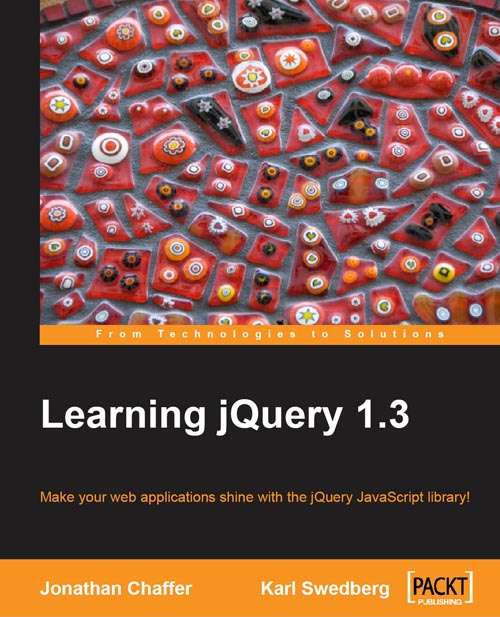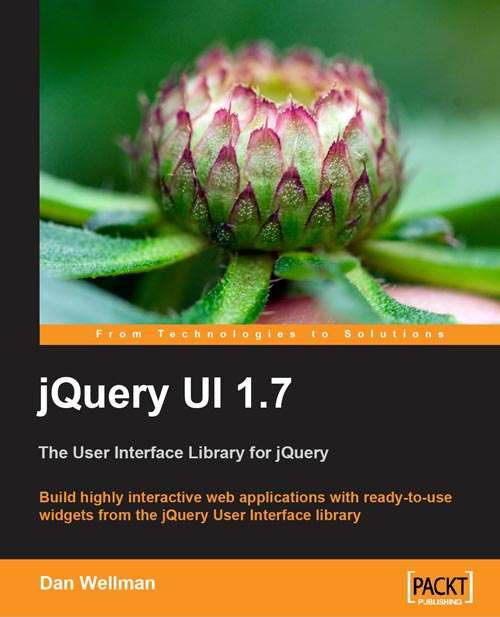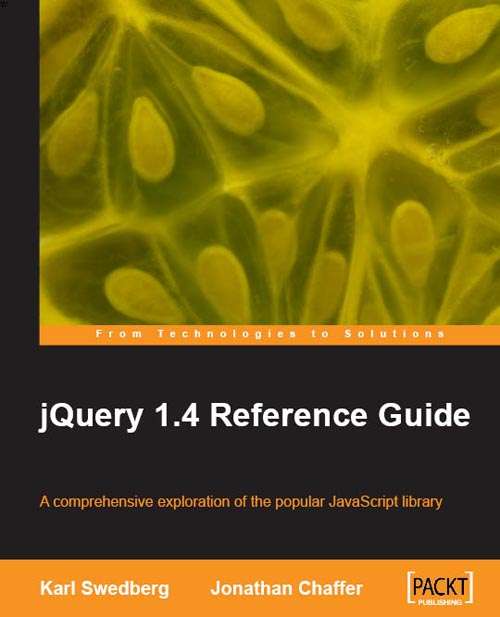jQuery Extravaganza!
If you know me, I'm easily one of the biggest web savvy guys out there. I've created some websites in less than one hour and some websites that took three months. It's not the creating them what I love the best about web development, it has to be the tools I get to use to get my work done.
jQuery, easily one of the biggest web development JavaScript frameworks out there, has been getting more and more attention in the last four years. In 2007, I found out about jQuery and haven't looked back ever since. jQuery has been emerging as one of the best JavaScript frameworks out there to help you get your work done and along with providing visual feedback to the user all at the same time.
jQuery has had one main goal throughout it's entire course of its life... and that is to make your web development experience enjoyable to code and also enjoyable to the user viewing that website. Many websites taking advantage of transitions like fading, having interactive web elements on the page, and everything else in that nature are powered by jQuery, or at least some JavaScript framework. If you're not a web developer, all this means is that you're going to be able to view the websites you visit in a more interactive way without even refreshing the page!
Over the past month or so, I've been quite busy on getting my hands messy with jQuery. We've reviewed one Packt book so far and we've even wrote about their open source awards (which I clearly voted for jQuery in one of the awards). But you know what, we're not going to stop there.
With the help of Packt, we're having a jQuery review extravaganza! Packt has been more than generous to let me review Learning jQuery 1.3, jQuery UI 1.7: The User Interface Library for jQuery, and even the jQuery 1.4 Reference Guide! Yes, that's right, we're reviewing three jQuery books in one post! Call that an extravaganza; let's get on with the review!
Note: I will be perfectly honest, this review was rather difficult for writing about three books in one post. I was aiming for a not too long of a post, but instead a post that's short but not so long that it looks intimidating. Hopefully you guys think that too!
My Background in Web Development
I've been in the web development field since 2001 and you know what, I don't regret any bit of it. I started off learning the extreme basics of HTML and slowly worked my way through learning CSS. Forward seven years later and I started learning JavaScript, PHP, Perl, Python, SQL, and many other server-side languages. In mid-2009, I started diving into other libraries and frameworks to make my web development faster but with a variety of new features. I started working with frameworks/libraries like jQuery, Django, Catalyst, and some others along with it.
As you can see, I've been exposed to many server-side languages along with the frameworks that run along with them.
Learning jQuery 1.3
 Out of all of the technical books I have ever read, I really have to say this is one of the best that I've ever set my eyes upon. Written by two authors and with one of them, Karl Swedberg, being an English teacher! The grammar in the books is far beyond what I've seen in other technical books and it's very well written in general. So if you thought all developers have terrible grammar skills, you're wrong! :P
Out of all of the technical books I have ever read, I really have to say this is one of the best that I've ever set my eyes upon. Written by two authors and with one of them, Karl Swedberg, being an English teacher! The grammar in the books is far beyond what I've seen in other technical books and it's very well written in general. So if you thought all developers have terrible grammar skills, you're wrong! :P
If you're a web developer who understands HTML, CSS, and the basics of JavaScript, this book is for you if you want to get your hands a bit messy with jQuery!
Time for the full on review!
What the Book Covers
Once I finished Learning jQuery 1.3, I was amazed with how much content was fit into such a book. Being 444 pages, it's not one of the skinniest books out there but don't let that intimidate you because some pages are full with bits of HTML/CSS/JavaScript. I cannot think of one thing that Learning jQuery 1.3 doesn't cover, and to be rather honest, I think the book covers everything it could of! They didn't leave out anything and the chapters are very well placed.
Now let's see what Learning jQuery 1.3 covers:
- What and why jQuery does what it's best for
- Setting up jQuery along with injecting and executing the code
- All of the different selectors you can use including the rather famous $() function
- Performing events on the start of a page
- Learning how to set up jQuery to interact with keyboard events
- Effects like fading, hide and show, and even custom effects
- Manipulating the DOM elements or most simply, the HTML code
- Loading content dynamically with AJAX
- Styling and editing HTML tables
- Form verification and styling
- Creating a news rotator and image carousel
- Developing and using plugins along with a variety of recommended plugins to use
- Covering the use of the jQuery UI
- Lots of recommended online resources, development tools, and even a section on JavaScript closures
- And to sum it all up, a quick reference guide with a list of the jQuery methods you can use
Yeah, that's pretty much everything you need to know about jQuery's features.
This Book is Awesome
I cannot say how much I absolutely love this book. I've been using basic jQuery throughout the websites I've been developing, and I have to be honest, I learned quite a bit. The two authors who wrote this book are what I can call jQuery experts, and they know the best way of doing things.
There has been multiple instances in the book where there is more than one way to do something, and the authors help you and even explain why their way is the best way to do that certain function. I find this extremely useful in a variety of cases because there's never one way of doing something in any programming language. The "best" way isn't something you can teach yourself, instead, it's something that someone needs to teach you. I really believe that Learning jQuery 1.3 outlines exactly that.
The other two books we have (jQuery 1.4 Reference Guide and jQuery UI 1.7: The User Interface Library for jQuery) are actually somewhat in this book. Learning jQuery 1.3 has a simple reference guide which is no where in-depth as jQuery 1.4 Reference Guide and it even talks about the jQuery UI but nothing as in-depth as jQuery UI 1.7: The User Interface Library for jQuery. If you want to learn everything possibly you can about jQuery but not too much of it, Learning jQuery 1.3 is the book you want to get.
On the other hand, there really isn't anything that disappointed me while I was reading this book. Everything in Learning jQuery 1.3 is clearly stated and the content is outlined brilliantly in every chapter. I expect nothing more or nothing less from Learning jQuery 1.3. They have just the right amount of content in this rather hefty book.
jQuery UI 1.7: The User Interface Library for jQuery
jQuery UI 1.7: The User Interface Library for jQuery has a vast amount of content written in this rather small (well, compared to Learning jQuery 1.3) book. jQuery UI, which is built upon the readily available jQuery framework is really a vast amount of plugins for jQuery and has been widely known for its interface and functions.
The jQuery UI has been used on some top-notch websites because of its rather light interface and ease of use. Web developers love it because it's so easy to get things done and users love it because for one, it looks amazing and it's just such an easy interface to use.
The jQuery UI comes with a variety of themes and even some online software to make your own. It's extremely extendable just like the jQuery framework is, but it's meant for developing an user interface quicker than using jQuery itself.
You might be asking yourself why would someone use jQuery UI even though they have the jQuery framework right there. Well, jQuery UI is made by some of the world's smartest JavaScript developers. I'm not saying typical developers like us have no idea what we're doing, but we all know it's so easy to not properly remove something from memory... yes, I'm talking about those glitches in Internet Explorer! With using JavaScript frameworks like jQuery, it takes those bottlenecks out so we can do what we do best! Which is of course, create high-class websites!
What the Book Covers
If you compare jQuery UI 1.7: The User Interface Library for jQuery to the actual documentation and features available on the jQuery UI website, there's not one thing you'll be able to find that's not discussed in the book. I really have to say, Dan Wellman, the author of this book, really knows his stuff extremely well. He wrote the book in a way assuming you already understand the basics of jQuery, but in all seriousness, they couldn't of developed jQuery to be any easier. John Resig, the founder of jQuery, really laid that out from the start of the entire project, which as a web-developer myself, I cannot thank him enough for creating the foundation of such an easy to use framework with out-of-this-world features that make my life so much easier.
Now here's a simple run down of what jQuery UI 1.7: The User Interface Library for jQuery covers:
- Introducing the set up of the jQuery UI
- An introduction of ThemeRoller, or the online theming engine of the jQuery UI
- Explaining the files and classes that make up the framework
- Covering basic and advanced tab implementation and styling
- Using the accordion widget or the "collapsed" ordered list (hey, that's what I call it!)
- Introducing the rather simple, but ever so stylish, dialog box
- Making the "UI" in jQuery UI come alive with interactive sliders
- How to create a date-picker and editing it for your needs
- Getting some application feedback with 'em progress bars
- Covering the most important aspect with interacting with a web application, dragging, dropping, selecting, and resizing
- Making unsorted lists sorted with the rather advanced sortable methods
- Adding in all those cool and unique animations and transitions
Amazingly, there's no reference guide available in jQuery UI 1.7: The User Interface Library for jQuery, so you'll need to refer to the index if you ever so wish to look something up.
Amazingly Written by an Awesome Writer
What can I say, jQuery UI 1.7: The User Interface Library for jQuery has really taught me so much more that I cannot be so thankful for. I'll be honest, I've only used the jQuery UI several times but I have used jQuery before numerous times for my clients' websites.
Things that would take me five minutes to code using straight up jQuery would take one minute to create with using the vast amount of plugins in the jQuery UI. jQuery UI 1.7: The User Interface Library for jQuery is such an amazing book for this reason. If Packt won't punish me for saying this, but it's not as boring as Learning jQuery 1.3. And the main reason for that is mainly that the jQuery UI helps eliminate some things that slow us down. And hey, there's quite a bit of images too which you need in a book discussing any type of user interface.
One thing that I have to say is that because Packt offers free sample code of all of their books, it's really easy to follow along and even edit the code to add it into your project if you wish to do so. There's so much sample code included with jQuery UI 1.7: The User Interface Library for jQuery, with that I'm betting once you get through all of it, you'll be a jQuery UI genius.
Overall, I have to say, jQuery UI 1.7: The User Interface Library for jQuery is an amazingly written book with nothing I can recommend for it to be any better. From the screenshots the author includes to the complete source code they offer for free, it's really a steal for this book.
jQuery 1.4 Reference Guide
Now I have to say, the jQuery 1.4 Reference Guide is a book every web-developer needs to pick up! If you don't want to pick up the other two books we've reviews, your best bet would be to pick up this book for a complete run down of every single thing that was available in jQuery 1.4, which isn't too much different from the latest versions.
jQuery 1.4 Reference Guide is not really a "book" per se, which in my mind, no one would actually sit down and read this. The main reason for that is this book is a reference guide; an rather in-depth one in fact.
After reading all of these jQuery books myself, having jQuery 1.4 Reference Guide on my side will be extremely helpful. Basically, what jQuery 1.4 Reference Guide does for you is list all the available features in jQuery and gives a great run-down along with some example code for each one.
You may be thinking, well for a 336 page book, how much is there? Feel free to check out their sample chapter for a closer look. It's a clear and rather organized way of summarizing everything about jQuery and I will guarantee you, it'll help you in your jQuery development.
What the Book Covers
From what you can already guess, the jQuery 1.4 Reference Guide covers practically everything available in jQuery. But just for your purpose, I'll give you a run-down.
The jQuery 1.4 Reference Guide covers:
- The basics of a jQuery script
- Selector expressions
- DOM traversal methods
- DOM manipulation methods
- Even methods
- Effect methods
- AJAX methods
- Miscellaneous methods like the $.noConflict() method
- jQuery properties to return certain info
- The plug-in API
- Quick reference
- Online resources
- Development tools
Basically from what I've said before, practically everything on the jQuery framework and more!
What Can I Say, What a Great Reference Guide
Just like the heading says, I really cannot say anything more for a reference guide. The thing that really brings this book out is that it basically takes the examples from the jQuery documentation, gives some great descriptions on how to use that certain method and why it's used in the first place.
I can not expect anything more. It's has just the right amount of words for every method, it lays them out in a real-world situation, and in the end of it, it'll teach you how to use that method if you forget a certain part of what to pass through it.
If you're looking for a reference guide to have in your own hands or when you're without an internet connection or even on the go, the jQuery 1.4 Reference Guide is for you. It's so easy to look something up in the rather organized index, and see how to use it and why it is used.
Overall
I really have to say, all three of these books, Learning jQuery 1.3, jQuery UI 1.7: The User Interface Library for jQuery, and the jQuery 1.4 Reference Guide do an excelllent job of teaching you everything you need to know about jQuery.
If you're looking for a book to teach you jQuery in the first place, Learning jQuery 1.3 is for you. If you're looking for a book to teach you the jQuery UI, jQuery UI 1.7: The User Interface Library for jQuery is a great start. And finally, if your looking for a book to sum up it all up for you, the jQuery 1.4 Reference Guide does a fantastic job at it.
To sum all all of this up, if you're a web-developer looking to learn any part of jQuery from its effects to the AJAX features or in need of some simple reference from time to time, looking at these three books by Packt would be a great start.
If you want to read more about the following, you may visit their websites:
Official jQuery website: http://www.jquery.com
Official jQuery UI website: http://jqueryui.com
Book on learning jQuery: Learning jQuery 1.3
Book on learning the jQuery UI: jQuery UI 1.7: The User Interface Library for jQuery
Reference guide on everything jQuery: jQuery 1.4 Reference Guide



Stalk me on social media! Any other way would just be creepy…
Follow me: